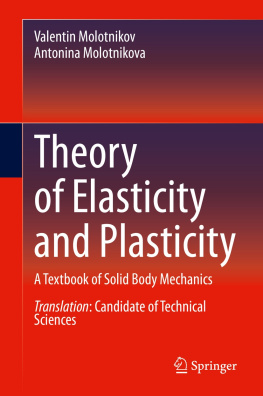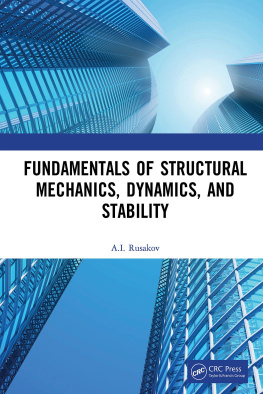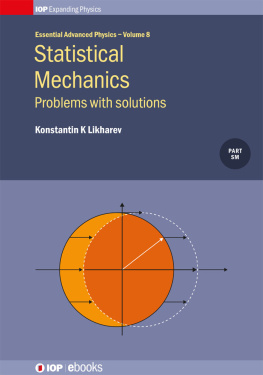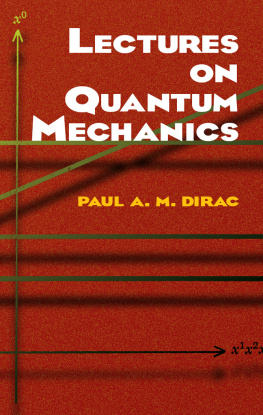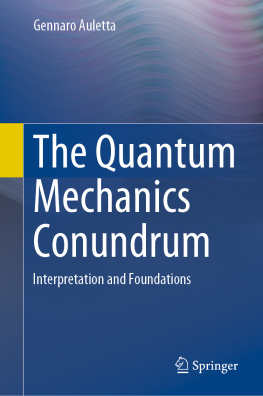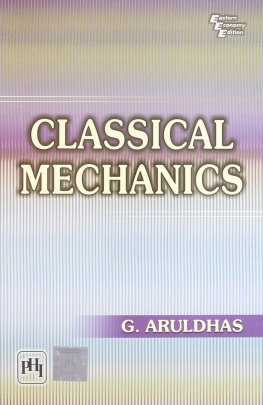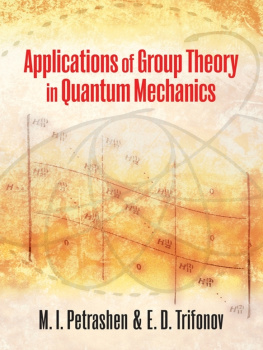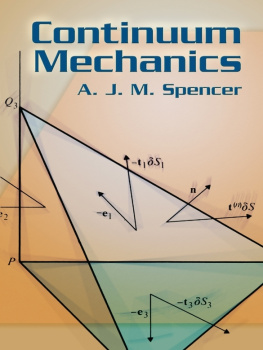Valentin Molotnikov and Antonina Molotnikova
Theory of Elasticity and Plasticity
A Textbook of Solid Body Mechanics
1st ed. 2021
Translation: Candidate of Technical Sciences

Logo of the publisher
Valentin Molotnikov
Don State Technical University, Rostov-on-don, Russia
Antonina Molotnikova
Institute of Management and Entrepreneur, Rostov-on-don, Russia
ISBN 978-3-030-66621-7 e-ISBN 978-3-030-66622-4
https://doi.org/10.1007/978-3-030-66622-4
The Editor(s) (if applicable) and The Author(s), under exclusive license to Springer Nature Switzerland AG 2021
This work is subject to copyright. All rights are solely and exclusively licensed by the Publisher, whether the whole or part of the material is concerned, specifically the rights of translation, reprinting, reuse of illustrations, recitation, broadcasting, reproduction on microfilms or in any other physical way, and transmission or information storage and retrieval, electronic adaptation, computer software, or by similar or dissimilar methodology now known or hereafter developed.
The use of general descriptive names, registered names, trademarks, service marks, etc. in this publication does not imply, even in the absence of a specific statement, that such names are exempt from the relevant protective laws and regulations and therefore free for general use.
The publisher, the authors and the editors are safe to assume that the advice and information in this book are believed to be true and accurate at the date of publication. Neither the publisher nor the authors or the editors give a warranty, expressed or implied, with respect to the material contained herein or for any errors or omissions that may have been made. The publisher remains neutral with regard to jurisdictional claims in published maps and institutional affiliations.
This Springer imprint is published by the registered company Springer Nature Switzerland AG
The registered company address is: Gewerbestrasse 11, 6330 Cham, Switzerland
The authors are grateful to D.Sc. in Physics and Mathematics, Professor L. M. Zubov and D.Sc. in Engineering, Professor V. P. Zabrodin for their selfless work in reviewing the manuscript, valuable advice and comments that were taken into account when preparing the final edition of the book. We express special gratitude to our son Zaur who inspired us for creating this work and took up most communications with the Springer publishing house. We are also grateful to Candidate of Technical Sciences Yu. V. Subachev who translated this book.
Dedication This book is dedicated to our children, Zaur and Alexandra. Thanks to them, we sought to enrich the world with a particle of new knowledge. Valentin and Antonina Molotnikovs
Preface to the English-Language Edition
This book was written based on the course of lectures given by the authors for many years to students of industrial and military universities of the Soviet Union and post-Soviet Russia. It also reflects the experience of the authors work at academic institutes of the USSR.
The book was published in Russian by Lan, St. Petersburg, in 2017. Since then, the authors and the publisher have received several opinions of students, post-graduates, and colleagues indicating the relevance of translating the book into foreign languages and publishing it abroad.
The first step in implementing these wishes was a translation into the Vietnamese language on the initiative of Mr. Le Quang Hoa and colleagues from the Hanoi Technical University. Knowing that about 100 million people communicate in Vietnamese in the modern world, the authors supported this initiative.
Unlike the first edition, the proposed English version of the book includes revised sections highlighting the history and development of the mechanics of deformable solid bodies. Materials whose utility is regarded as low have been removed. The book design has also been modified taking into account the Springers rules.
When writing this book, the authors intended to help students in mastering the methods of elasticity and plasticity theories, by demonstrating their use with practically important examples and preparing readers for the conscious use of multiple computer programs for analysis of engineering structures. Research methods used in the book require the knowledge of mathematics and the strength of materials in the scope of the university training program.
Antonina Molotnikov
Valentin Molotnikov
Rostov-on-Don, Russia Rostov-on-Don, Russia
Preface
As defined by M. Ya. Leonov, the mechanics of a real solid body is not only engineering, technology, and mathematics, but also a concentrate of rationality, a powerful engine of social progress, and an example of classical natural science.
A fundamental and the most complete section of the mechanics of deformations is classical elasticity theory occupying about a quarter of the book. The subject matter is described with an increasing complexity of topics. The existing boundaries between the educational and scientific literature are erased. The book includes the authors solutions to a number of new problems important for engineering applications.
A quarter of the book is dedicated to principal variants of plasticity theory. It is preceded by a short overview of plasticity theory from the first experiments of Coulomb to endochronic variants of the theory and unconventional (synergetic) models of our days. Primary attention in this part is paid to the theory of small elasticplastic deformations by HenckyNadaiIlyushin, since this theory allows solving the most important problems of engineering. It also discusses the flaws in strain theory and the limits of its applicability.
The second part of the book is represented by the authors studies in the development of the sliding conception in plasticity theory as set by M. Ya. Leonov. The BatdorfBudiansky sliding mechanism is taken as the basis. Solutions to some problems eliminate primary objections against the BatdorfBudiansky model and rehabilitate the sliding concept in plasticity theory.
The conclusion is made that due to the complexity of this matter, it must be admitted that creating a unified, universal, and rather complete theory of plasticity has not been successful by using either classical methods of mechanics of continuous media or semi-physical synergetic methods. Therefore, one must expect that in the nearest decades, high attention will be paid to simplified partial models. A model of complex deformation of materials with a residual change of volume is given as an example of such simplified setting.
Valentin Molotnikov
Antonina Molotnikov
Rostov-on-Don, Russia Rostov-on-Don, Russia
Abstract
At the beginning, the book was conceived as a textbook for the classical course in solid mechanics. However, at the exit, it turned out that most of the book was written in the form of a monograph, contains many references and broadly represents the authors developments. In addition, the book describes the main achievements of the modern development of the mechanics of elastic and inelastic materials. The book is intended not only for getting interested persons familiar with the primary results of mechanics development, from the first Coulomb experiments to the late twentieth or the early twenty-first century, but also for stimulation of practical use of new achievements of the deformation theory in geomechanics, mining, and construction industry. The book is presented for senior students majoring in structural analysis and experts in the field of solid mechanics. The book materials can be used as a topic for theses, and the solutions given are the methodological basis for students and post-graduates of the Construction, Applied Mechanics courses, etc.

